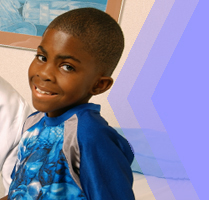


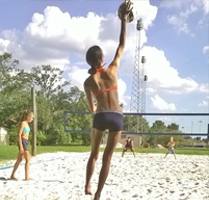

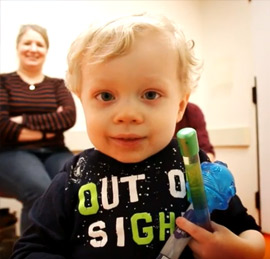
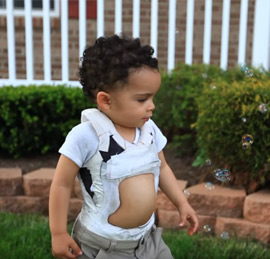


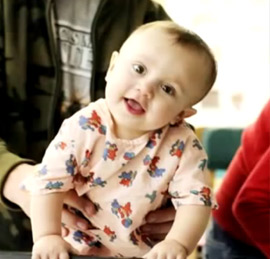


Evonte
Hope for the Future
Evonte was born with scoliosis and fused ribs, with a spine curvature of more than 50 degrees. Despite being small for his age and the phyisical problems he had, Evonte enjoys riding bikes, playing basketball, and playing outside with his brothers and sister. However, due to the scoliosis and fused ribs,Evonte's lung capacity was small. As his scoliosis progressed, problems with lung capacity grew worse.
At age 3, Evonte underwent spinal fusion surgery, due to the rapid progression of his spine curvature. For six months following the surgery, he wore a back brace. Although the fusion surgery prevented the abnormally shaped bones in his spine that were causing the curver to further deform his spine, it was not enough to help his lungs to grow as he did.
When he was 9 years old, Evonte received his initial VEPTR implant at the Campbell Clinic. Implanted by Dr. Jeffrey Sawyer and Dr. Robert Warner, the VEPTR allows spine surgeons to halt and sometimes correct spine curvatures; in addition, the device allows a patient's lungs to grow and develop, as the device grows with the patient. This can be critical to patients with spine and chest wall deformities, as children whose lungs are too small can have a wide variety of medical problems including fatigue, poor growth and weight gain, frequent respiratory infections and, in severe cases, even death.
After recovering from the surgery, Evonte is back in school, and back to being the active boy he was. He celebrated his sister's birthday just months after his surgery, even taking his turn jumping in the moon-bounce. "You can see a difference in the way he sits and he walks," said Yolanda Cathey, Evonte's mother. "He's sitting up straighter and walking taller. He looks really good."
Before

After

Christopher
A Parent's Perspective
"On June 14, 2008 Christopher was exactly 6 months old and we were told something was wrong and we should see a specialist at a leading hospital in the country. After a whirlwind of X-rays, MRI, renal, and cat scans, they said they could not help Christopher's severe spinal condition. Off we went to find someone that could. At that point we just wanted to know what options, if any, were available to us.
Up and down the east coast we traveled and ultimately found our way into Dr. Michael Vitale's office. He not only provided options but he gave us hope. He told us that his condition was indeed very challenging and a number of things can and probably will go wrong, but there was not only new research that dictated a course of action that may not deprive him of a physically compromising future, there was now technology that could get him there. Technology that did not exist just a few short years prior. Christopher's condition does not make him the ideal candidate. In fact, there was (and still is) a good chance it could make it worse. Research however is telling us that it is well worth the try. We are happy to say that the path we chose has allowed Christopher to experience the joys every young child should.
Are we out of the woods yet? Of course not. But we remain cautiously optimistic and at the same time endeavor to make Christopher's future limitless and unbounded by his condition. Eleven surgeries before his 6th birthday and enduring an annoying brace all day long every day is challenging, but Christopher knows what it like to ski, swim, go on Disney rides, bike, slide down a water slide, score a goal in a soccer league, play t-ball, and take the bus to kindergarten." - Christopher's parents
Before
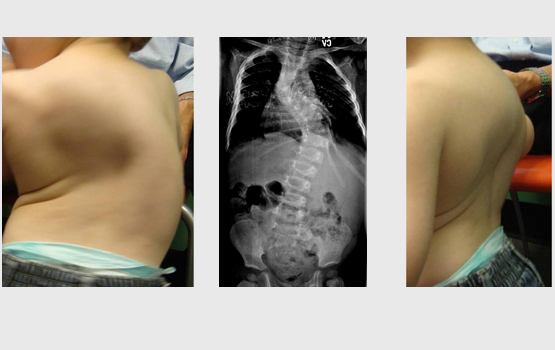
After
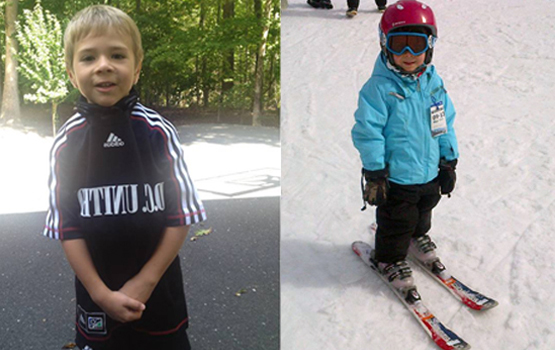
Bella
Bella was 15 months old when we first noticed her shoulder blades were a little uneven. We took her to her pediatrician and the doctor ordered an x-ray which showed an upper Sshape curve. We were then referred to a children's hospital in a city nearby. After meeting with that particular specialist at the local hospital we were overcome with fear as any new parents would be. One of the first things we had to do was have Bella's heart and kidneys checked but thankfully there were not any issues with her organs. The first specialist recommended a brace and then surgery by the age of 13. It immediately didn't sit well with us and that is when I started searching for other doctors, and treatment options.
I discovered a Facebook support group for Progressive Infantile Scoliosis and learned about Dr. Mehta and Mehta casting. We were lucky in the fact that there were three hospitals located in Texas, Chicago and Ohio that we felt like we could get to. We saw another specialist near us in Springfield, IL but still felt like Chicago was calling us for treatment. After traveling to Chicago after a long wait list we saw Dr. Hammerburg. He read the MRI and told us Bella's curve was 56 degrees and the current x-ray looked worse than her original. He recommended casting and that is what we chose to do. Dr. Hammerburg also noticed she had hip dysplasia on the MRI, which two doctors missed completely back home. Bella was around 20 months old when she received her first Mehta cast and hip brace in Chicago.
After Bella received her first Mehta cast we were able to go home the same day. We came back a week later for Dr. Hammerburg to check on her and the cast. We then saw her doctor every 9-12 weeks for another X-ray to watch her curve and a new cast. She received a week break and then she had a new cast put on. Bella has a flexible spine so her spine took well to the casting process and we have been able to avoid surgery so far.
Bella had a total of 12 casts and then around age 5.5 she was able to move to a Mehta style brace before she started Kindergarten. She wore the brace 23/24 hours a day, and was able to have a break from the brace at school when participating in recess and PE. She also takes off the brace when she goes to dance class. Bella is now in 2nd grade and is in her third brace. Each brace seems to last awhile and seems to be holding her curve. We have not had any correction from the brace, but her curve also hasn't gotten any worse since her bracing started.
Our biggest struggle in the beginning with casting was finding daycare that could help Bella and her special casting requirements. She overheated easily and couldn't get wet, play with sand or get too dirty outside. All of these requirements are difficult when trying to find a quality daycare. Currently, as a second grader she is just trying to fit in with her peers. We also make sure her teachers are sympathetic and so far she has had great teachers that are always willing to help.
Bella loves to go to the lake, fish, swim and boat. Bella loves to ride her bike, play the piano and take dance class. She really likes to explore outside, put little creatures under her microscope, and wants to be a scientist when she grows up!
Before
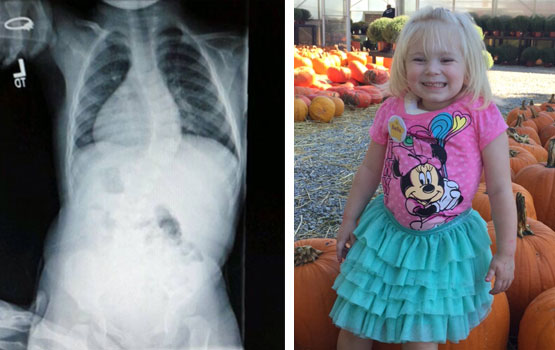
After
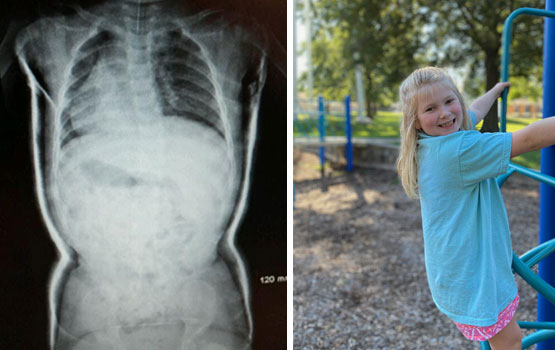
Hi! I'm Kaitlyn
I was diagnosed with scoliosis at the age of 9 at a pediatrician well visit. The doctor found that I had a lumbar curve in the high 20's as well as a thoracic curve in the low 20's. I immediately began wearing a Providence brace at night. At first it was a fight, but once I got more comfortable with it I was very compliant in wearing it to bed without too much fuss. We visited the orthopedic doctor every four months and were continually told that "everything looked good", so we felt confident that I was going to get through this without much worry.
Fast forward two years. I started complaining that my brace hurt and I didn't want to wear it. I had been wearing the same brace the whole time so we made an appointment earlier than planned to see about a new brace. I was shocked when the doctor told me that my curve was now 41 on the top and had actually been getting worse over the last year! We decided to switch to a Boston brace so that it could better address my high curve, but I would have to wear it pretty much full time.
I wore the brace to school once and came back refusing to ever endure that again. I couldn't even go to the bathroom without help and I was NOT going to do this! We watched videos online of girls showing how to do cute outfits and we did a ton of shopping hoping to find ways to make this acceptable to me, but I was quickly pulling away from social activities and friends and changing from the happy energetic girl that I was once was. I worried I was going to have to give up volleyball, a sport I loved, and I refused to spend the night with friends or participate in activities because I was embarrassed about my shoulder blade sticking out.
My mom spent hours pouring over the internet and ruling out several of my options, we decided to visit Shriners in Philadelphia to talk to Dr. Cahill about Vertebral Body Tethering (VBT). He felt I was a perfect candidate and we jumped in head first without looking back. My thoracic curve was at 46 degrees on the day of surgery and lumbar was still in the high 20's as it had always been. Dr. Cahill tethered the top of my spine and left the bottom alone. Six weeks later I was back playing volleyball.
Since then, my life has been a series of amazing events that I think all would have never happened if I'd stuck fighting the brace! I won a Disney essay contest with a story I wrote about my VBT experience and won premium annual Disney passes for the family for a year. I had an opportunity to speak in Washington, DC at the FDA spinal devices meeting about my outcome and experience with VBT.
I made my club's national volleyball team and at the national tournament, I was scouted by an agent for a major modeling agency and I have been modeling for the last four years. I also was hired to write a monthly column for a modeling magazine.
I went from 5'4 on the day of surgery to 5'11 now, almost six years later and my spine is almost completely straight! It has inspired me to want to become a doctor. I worked hard, graduated from high school a year early and was awarded a full scholarship to a prestigious private college, Stetson University. I am majoring in biology/pre-med and playing club volleyball for my college, and continuing to model - signed with Freedom Models LA. I hope to become a radiologist and help others the way my doctors have helped me.
Before
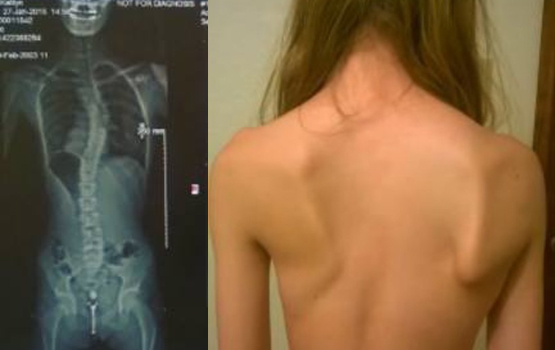
After
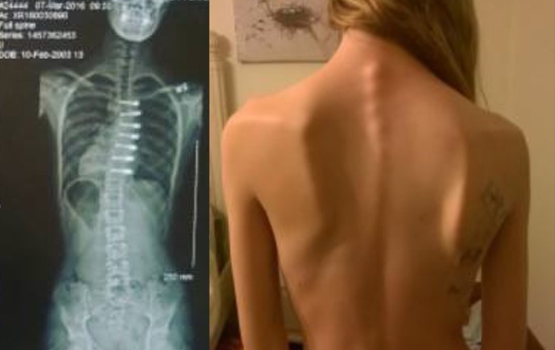
Ella
Learn about juvenile idiopathic scoliosis and treatment with a brace from Ella and her mother Meg. Meg explains how they noticed the scoliosis as well as what treatment is like with a brace.
Faron
Learn about serial body casting to treat infantile idiopathic scoliosis from Faron, and his parents Lisa and James. They also explain how they noticed the scoliosis as well as sharing tips and tricks when Faron was in the cast.
Hector
Learn about serial casting for early onset scoliosis from Hector and his Mom, why it is important to treat early and what impact this treatment can have on a curve in the spine.
Lauren
Age 6
Follow Lauren and her family as she prepares for treatment of her spine with serial casting, halo gravity traction and magnetically controlled growing rods.
Emily
Age 5 to 13
Watch these two videos of Emily at age 5, and again seven years later, and follow her story of diagnosis and treatment first with halo gravity traction, then growing rods.
Addyson
Age 6 months
Watch Addyson and her family as they receive a diagnosis of Infantile Scoliosis and receive treatment with serial casting.
Max
Age 11
by Behrooz A. Akbarnia, MD
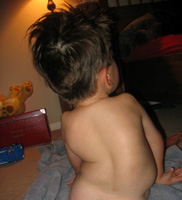 Max was a small, very pleasant 3.5 year-old boy when he was first seen as a second opinion for treatment of his progressive Early-Onset Scoliosis (EOS). His parents had heard about dual growing rod surgery and would like to know more about it.
Max was a small, very pleasant 3.5 year-old boy when he was first seen as a second opinion for treatment of his progressive Early-Onset Scoliosis (EOS). His parents had heard about dual growing rod surgery and would like to know more about it.
Max had been diagnosed with arthrogryposis at birth and had several moderate to severe joint contractures in both upper and lower extremities in addition to his obvious spinal deformity. He was the second child of the family and his mother had an uneventful pregnancy and delivery. Max had had several surgical procedures to release multiple joint contractures before coming to visit us for his scoliosis. He had a normal mental development and appeared very smart and cooperative.
He had undergone non-operative treatment with brace with little success. He had a good sitting balance and head control when I first visited him in early 2005.
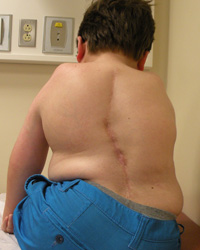 Because of the progression of his curve and pending pulmonary issues surgical intervention was recommended. However, Max was very young and had a fairly high chance of experiencing unwanted consequences during the course of anticipated long treatment.
Because of the progression of his curve and pending pulmonary issues surgical intervention was recommended. However, Max was very young and had a fairly high chance of experiencing unwanted consequences during the course of anticipated long treatment.
After discussing the risks and benefits of surgery with growing rods, the family decided to proceed with surgical treatment. My goals of his treatment were to delay the rate of scoliosis progression as much as possible, maintain and assist him to achieve his longitudinal spinal growth and sitting height, helping him to maintain his current sitting balance and finally providing his lungs with more room to grow by correcting his spinal column (mainly thoracic spine) alignment and growth.
Max underwent the index growing rod surgery in August 2005 at the age of 4. From August 2005 to June 2012, Max went through eight lengthenings before his definitive spinal fusion at the age of 11. His latest assessment showed that his scoliosis corrected by more than 40% and his spine grew for about 7.2 Cm throughout the course of treatment.
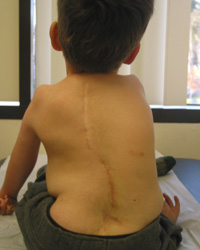 However, this achievement was not easy for the patient, his family and his treating surgeon. Arthrogryposis is one of the most challenging conditions in orthopaedic disorders. Spinal deformity usually presents very early in life and is progressive. Non-operative treatment is almost always futile and operative treatment is prone to repeated failures and complications. Beside his successful GR lengthenings and final fusion, Max had to go through 5 major revisions and 4 surgeries for wound issues. He suffered from deep surgical site infection twice during his treatment course but we were able to save his previous scoliosis correction and height gain without terminating his growing rod treatment.
However, this achievement was not easy for the patient, his family and his treating surgeon. Arthrogryposis is one of the most challenging conditions in orthopaedic disorders. Spinal deformity usually presents very early in life and is progressive. Non-operative treatment is almost always futile and operative treatment is prone to repeated failures and complications. Beside his successful GR lengthenings and final fusion, Max had to go through 5 major revisions and 4 surgeries for wound issues. He suffered from deep surgical site infection twice during his treatment course but we were able to save his previous scoliosis correction and height gain without terminating his growing rod treatment.
Max is now fully recovered following his final fusion. He and his family are very happy of the treatment they chose to continue with. Max has an excellent sitting balance, very acceptable clinical and radiographic deformity correction and most importantly near normal spinal height and effortless and independent respiration.
Maddie
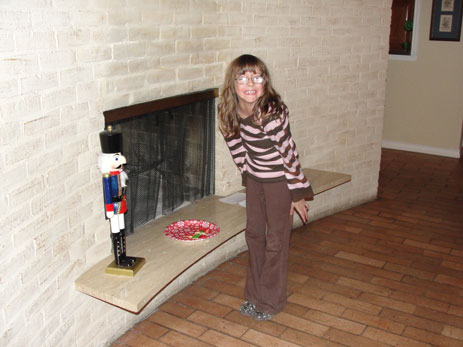
Age 11
by Behrooz A. Akbarnia, MD
Maddie has Marfan syndrome, diagnosed in infancy, with scoliosis evident soon thereafter. After 5 years with the prior treatment, at age 7, Maddie's posture seemed to be distorting more and more at the shoulders and her upright position was not improving, so we decided she needed an evaluation for a more correctable device (Fig 1).
Having attended the National Marfan Conference, we were given the hope we needed for Maddie to correct her posture by using the growing rods. The growing rods were a total transformation. To our surprise, after removal of the device and placement of the growing rods, we immediately noticed she could raise her left arm all the way up when before she could only raise it 45 degrees (Figs 2-5).
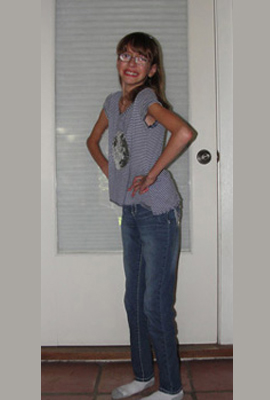
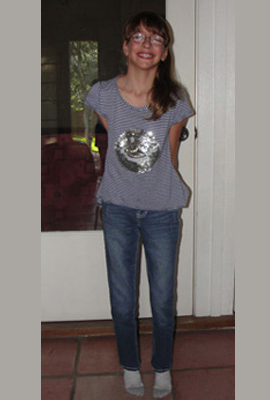
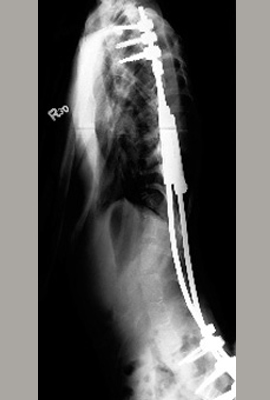
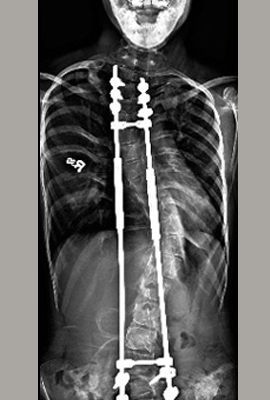
There was also immediate and dramatic improvement in her posture. She is now able to lay on her back with legs straight out without any discomfort. Where it was previously difficult for her to look up because of her forward lean, she is now relatively mobile in all directions and is able to fully turn and tilt her head. Maddie claims her clothes fit and look so much better since she got her new rods. Our only regret is that we didn't learn about the growing rods sooner.